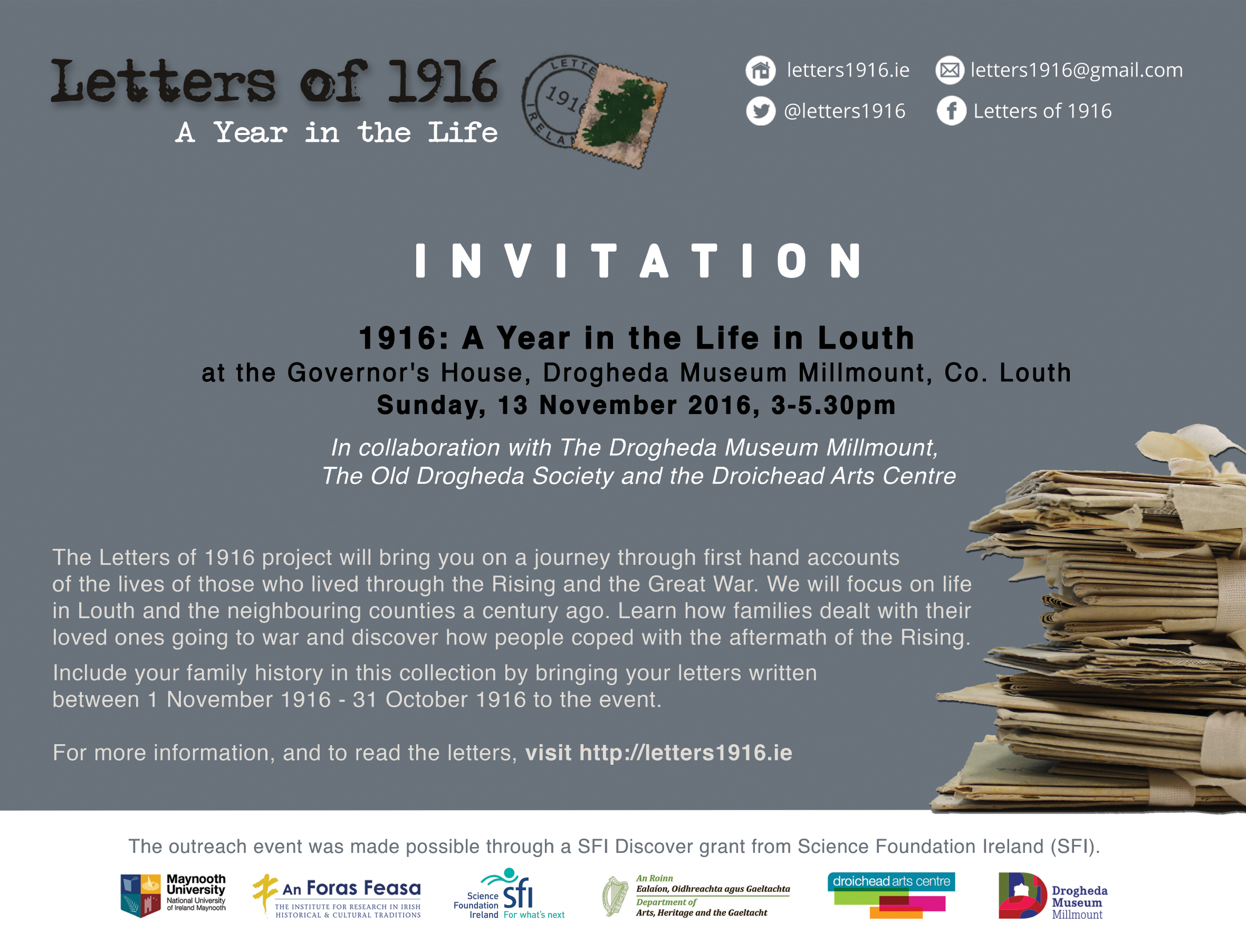Join us on Sunday, 13th November 2016 at The Governor’s House, Drogheda Museum Millmount, Co. Louth to learn more about ‘1916: A Year in the Life in Louth’. The event is organised in a collaboration with the Drogheda Museum Millmount, The Old Drogheda Society and the Droichead Arts Centre and is part of an exciting programme of events on 13 November (click here for more information).
The Letters of 1916 project will bring you on a journey through first hand accounts of the lives of those who lived through the Rising and the Great War. We will focus on life in Louth and the neighbouring counties a century ago. Learn how families dealt with their loved ones going to war and discover how people coped with the aftermath of the Rising.
Include your family history in this collection by bringing your letters written between 1 November 1916 – 31 October 1916 to the event.
1916: A Year in the Life in Louth
at The Governor’s House, Drogheda Museum Millmount, Co. Louth
Sunday 13 November 2016, 3.00pm – 5.30pm
ALL WELCOME

In the meantime, explore some of the letters related to County Louth contributed to the project:
Letter from Michael James Quin to Alice Stopford Green, 28 July 1916
National Library of Ireland
This letter was written by Michael James Quin (b.1862), a priest from Co. Louth. The letter was addressed to Alice Stopford Green (1847-1929). Green the wife of historian John Richard Green, (1837-1883), was a nationalist, involved in the Howth gun-running and a historian in her own right. She was shocked by the 1916 rising and horrified that Casement had been plotting to obtain German assistance. Nonetheless, she visited Casement in prison and lobbied hard to prevent his execution. In the letter Quin states that he is enclosing a petition in favour of Roger Casement (1864-1916). Roger Casement had been imprisoned in London after he had been arrested while landing on the coast of Kerry in a submarine on the eve of the Easter Rising. A campaign was launched featuring many prominent figures such as W.B. Yeats and George Bernard Shaw to secure a reprieve for Casement but he was hanged on 3 August 1916. Quin believes that Casement’s execution will rouse deep feeling throughout Ireland.
Letter from Philip J. McArdle to John Dillon, 21 May 1916
Trinity College, Dublin
Letter from Philip J. McArdle to John Dillon (1851-1927). The writer delivers an account of a conversation he had on board a boat in Greenore, Co. Louth, with a soldier from the Royal Irish Rifles. The soldier recognised Francis Sheehy-Skeffington in a front page picture of the newspaper which Mr. McArdle had been given and this gave rise to the conversation. It emerged that the soldier had been part of the firing squad at Portobello Barracks which executed Sheehy-Skeffington and two others. He described the shooting of Sheehy-Skeffington, saying that he was shot as he lay on the ground. He named the officer in charge as Adjutant Morgan and said that all of the firing party were from Victoria Barracks.
Letter from Thomas Parr to the Under-Secretary, 22 April 1916
National Archives of Ireland
Letter from Thomas Parr to the Matthew Nathan (1862 – 1939), the under-secretary for Ireland, asking for his fuel return form to be corrected. Parr writes that he made a mistake in his earlier claim and that instead of 5 tins (10 gallons), he had put in 5 gallons of petrol. He asks for the mistake to be rectified.
Sir Matthew Nathan was the under-secretary for Ireland from 1914 to 1916. In 1916 Nathan offered his resignation following the outbreak of the Easter Rising.
Letter from Alexander Gartlan to Henry Wynne, 8 August 1916
National Archives of Ireland
This letter was written by Alexander Gartlan (1852 – c. 1951), crown solicitor for County Louth, to to Sir Henry Arthur Wynne (1867 – 1945). Wynne was appointed to the vacant position of chief crown solicitor following the death of Sir Malachy Kelly (1851-1916).
In this letter Gartlan requests a week of leave for a short holiday. Enclosed with the letter are Gartlan’s application and a letter of consent.
Letter from John Bernard Connolly to the Under Secretary of Ireland, 14 July 1916
National Archives of Ireland
Letter from Drogheda town clerk, John Connolly (1878-1919) to the under secretary of Ireland regarding Article 31 of the Schedule to the Local Government (Application of Enactments) Order, 1898. Connolly inquiries whether it is possible to have the number of members on the council altered.
At the time this letter was written Sir Robert Chalmers (1858 – 1938) was serving as the under secretary of Ireland. Chalmers was sent to Ireland as a replacement for Sir Matthew Nathan, who had resigned along with Augustine Birrell, his chief secretary, following the outbreak of the Easter Rising in 1916.
Letter from Edward O’Farrell to John Bernard Connolly, 20 July 1916
National Archives of Ireland
Letter from the Assistant Under Secretary of Ireland, Edward O’Farrell (1857-1926), to Drogheda Town Clerk, John Connolly (1878-1919) in response to a previous inquiry from Connolly regarding Article 31 of the Schedule to the Local Government (Application of Enactments) Order, 1898. The inquiry concerned an increase in the number of members on the council. According to O’Farrell Connolly should seek an appropriate answer from the town’s legal advisors.
Letter from Margaret Donnan to Jane Donnan, 28 April 1916
Private Collection
Letter from Margaret Donnan, a 50 year old mother to her 24 year old daughter who was working in Post Office in Killyleagh Co Down, urging her to apply for work in the Ballymena Cottage Hospital.
This letter tells of events that Margaret and her 10 year old daughter witnessed from her upstairs window in Castlebellingham Co Louth and information she gathered from neighbours.
It also tells of her husband volunteering to guard the railway bridge with other men from the village. This letter also gives news of two sons that had enlisted and were in France, a 17 year old daughter who had recently gone to work in the post office in England, and another son at home taking food to his father guarding the bridges from being blown up.
The Donnan family were Presbyterian. Members of the family, including Margaret, had worked for the Bellingham family. Margaret was a cook. The family would not have been sympathetic to the Rising.
Enclosed is a very sad photograph. Three years before it was taken, in 1905, they had lost two children, a baby boy aged one year and a little girl who died aged two, just 4 months before the youngest child in the photograph was born.
Letter from Thomas Halpin to Davy Blood, 15 June 1916
Drogheda Museum, Millmount
This letter is from Thomas Halpin, an internee at Wandsworth Prison in London, to Davy Blood. Halpin, ordinarily resident at 2 Stockwell Lane in Drogheda, Co. Louth, was sent from Richmond Barracks to Wandsworth on 8 May 1916.
In the letter, Thomas discusses conditions at the prison and discusses his anticipated release. He discusses two fellow prisoners who were recently moved ‘West’ to another internment camp & he expects that the rest of them will be moved soon. The news was welcome as prisoners in the other camp are afforded privileges (such as smoking) which those in Wandsworth are not.

The outreach event was made possible through a Science Foundation Ireland (SFI) grant. This funding allows the Letters of 1916 project to extend its outreach with five Community Engagement Events in 2016 (Donegal, Kerry, Sligo, Clare & Louth).